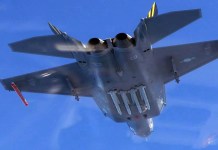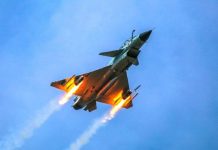Japan had revoked its decision to cancel procurement of US-made RQ-4 Global Hawk surveillance drones in 2020, apparently to placate then-US President Donald Trump, according to the latest Japanese media reports.
A newly emerged report suggests, the then government of Shinzo Abe had told Washington in the spring of 2020 that it would not buy the Global Hawk drones owing to their high prices, but the decision was reversed after Tokyo shelved plans to deploy US-developed land-based Aegis Ashore ballistic missile defense systems in June of that year.
Tokyo apparently felt that canceling the Global Hawk deal would “anger Mr. Trump, who has insisted on exporting US-made weapons”, leading to a change in its policy. The episode demonstrated “excessive consideration for Mr. Trump”, the report claimed.
Japan’s RQ-4 Drone Deal
When Pyongyang conducted its third nuclear test in 2013, the Japanese Defense Ministry planned to acquire Global Hawk drones to monitor North Korean military installations in 2014.
The drones’ acquisition expenditures stood at 61.3 billion yen ($528 million), besides the yearly operating and maintenance cost of 13 billion yen. The Japan Air Self-Defense Force is expected to begin deploying Global Hawks in mid-2022.
In October 2017, a government-level contract was struck and an order was placed with Northrop Grumman the following year. The US Air Force Life Cycle Management Center is in charge of the purchase on behalf of the US government.
The contract included three fully-equipped air vehicles, two ground control stations, spares, and support services.

Japan plans to station three Global Hawk drones at the ASDF Misawa Air Base, which is home to the JASDF’s initial two squadrons of Lockheed Martin F-35As and its fleet of E-2C/D Hawkeyes, for a period of about 20 years at a cost of 263.7 billion yen. The ASDF established a unit of 70 people at the Misawa site in March last year to prepare for the drone deployment.
In April 2021, US defense company Northrop Grumman announced it successfully completed the first test flight of Japan’s RQ-4 Global Hawk. The RQ-4 Global Hawk, according to the drone manufacturer, will provide Japan with on-demand intelligence, surveillance, and reconnaissance information to support the Japan Air Self-Defense Force’s missions of border protection, threat monitoring, and humanitarian assistance in times of need.
Why Did Japan Want To Cancel The Deal?
The Global Hawk is capable of flying as high as 65,000 feet, beyond the reach of many air-defense systems. Its absence of stealth technology, on the other hand, makes it vulnerable to powerful surface-to-air missiles.
Iranian military shot down a US Navy Global Hawk that was flying near Iran in 2019. It claimed they shot down the drone with a Buk M1 road-mobile SAM.
The shooting down of the non-stealthy, high-flying drone alarmed American authorities. This was also said to be the main source of Japan’s concerns over the drone deal. There’s another element to consider. The US Air Force requested that Congress allow it to retire all 20 older camera-equipped Block 30 Global Hawks in 2021 and retain just 10 newer, radar-equipped ones (Block 40 variant). The Navy’s intention to buy 68 Global Hawks with electronic sensors hasn’t changed.

For the time being, US lawmakers have put the RQ-4 retirement on hold. The Japanese Defense Ministry, on the other hand, was concerned that if Congress approves the retirement, the cost of maintaining its three Block 30s would increase.
An assessment of the procurement plan undertaken by then-Defense Minister Taro Kono took into account the possibility of higher maintenance expenses as the US Air Force planned to retire the type of drone to be deployed by Japan, with the production of major components already halted. “It is impractical to fly them in the airspace of other countries,” a Defense Ministry official had said.
Kono announced in 2020 that the planned Aegis Ashore missile interception system deployment would be scrapped due to technical issues and rising prices amid strong local opposition.
Japan wants to enhance its surveillance and monitoring capability, owing to its thousands of islands and large territorial waters, as well as a hostile neighbor in the form of China and North Korea. Tokyo’s current surveillance capabilities include marine and land-based radars, manned patrol planes, and supersonic fighter reconnaissance pods.
Japan’s Maritime Surveillance Capabilities
Although Japan wants to keep a close eye on the East China Sea, where Tokyo and Beijing have a territorial dispute, the Global Hawks were built to monitor land regions, and diverting them for sea observation would be extremely expensive.
Japan has already sent many surveillance satellites into orbit. In 2021, it was reported that Japan is working on a maritime surveillance system that will utilize artificial intelligence (AI) and modern satellite technology to detect and monitor foreign ships that operate suspiciously near its waterways.
The new Japanese surveillance system, which will be demonstrated this year and deployed as early as 2024, would analyze massive quantities of data collected from satellites to detect the speed and direction of foreign ships.
Any suspicious movements will be flagged by the coast guard for further investigation. The islands of Okinawa Prefecture, which China claims and refers to as the Diaoyu archipelago but Japan calls Senkakus, are Tokyo’s main source of concern.
There have been several incursions into the waters around the uninhabited islands. Chinese coast guard vessels were seen near the islands for 157 days in a row until July 19, 2021, the longest continuous time since the region was purchased from its private owners in September 2012.
At a time when threats to Japan’s sovereignty are mounting, the technology will allow the coastguard and, perhaps, the Self-Defense Forces to track Chinese activity near its territory.
- Contact the author at ashishmichel@gmail.com
- Follow EurAsian Times on Google News




